Summers in Greece—Climate Analysis †
Abstract
1. Introduction
2. Methodology
Database and Datasets
- Trends in temperature and precipitation fluctuations (both monthly and seasonal).
- Trends in average temperature and precipitation (both monthly and seasonal).
- Comparative analysis of grid-based values across regions.
- Visual representation through diagrams and charts.
3. Results
3.1. Country Analysis
3.1.1. 500 hPa
3.1.2. 850 hPa
3.1.3. Total Precipitation
3.2. Region Analysis
3.2.1. Rate of Change per Year
3.2.2. Total Temperature Deviation at 500 hPa and 850 hPa
3.2.3. Total Precipitation Deviation
4. Conclusions
- Temperature at 500 hPa: Projected increase ranging from 1.2 °C to 1.7 °C.
- Temperature at 850 hPa: Projected increase ranging from 1.5 °C to 2.4 °C.
- Total Precipitation: Projected increase ranging from 1 mm to 92 mm.
Author Contributions
Funding
Institutional Review Board Statement
Informed Consent Statement
Data Availability Statement
Conflicts of Interest
References
- Diebold, F.X.; Kilian, L.; Nerlove, M. Time series analysis. In Macroeconometrics and Time Series Analysis; Springer: Berlin/Heidelberg, Germany, 2010; pp. 317–342. [Google Scholar] [CrossRef]
- forecast.weather.gov. NOAA’s National Weather Service-Glossary. Available online: https://forecast.weather.gov/glossary.php?word=hpa (accessed on 8 August 2025).
- Noaa.gov. Constant Pressure Charts: 850 mb. 2023. Available online: https://www.noaa.gov/jetstream/upper-air-charts/constant-pressure-charts-850-mb (accessed on 8 August 2025).
- Noaa.gov. Precipitation. 2024. Available online: https://www.noaa.gov/jetstream/atmosphere/precipitation (accessed on 8 August 2025).
- Met Office. Foehn Effect. Met Office. 2018. Available online: https://weather.metoffice.gov.uk/learn-about/weather/types-of-weather/wind/foehn-effect (accessed on 8 August 2025).
- National Weather Service. What Is an Inversion? National Weather Service Little Rock, Arkansas. Available online: https://www.weather.gov/media/lzk/inversion101.pdf (accessed on 8 August 2025).
- United States Environmental Protection Agency. What Are Heat Islands? USEPA. 2024. Available online: https://www.epa.gov/heatislands/what-are-heat-islands (accessed on 8 August 2025).
- Philandras, C.M.; Metaxas, D.A.; Nastos, P.T. Climate Variability and Urbanization in Athens. Theor. Appl. Climatol. 1999, 63, 65–72. [Google Scholar] [CrossRef]
- Kampolis, D. Statistical Analysis for Long-Term Weather Forecast. Environ. Sci. Proc. 2023, 26, 30. [Google Scholar] [CrossRef]
- Kambezidis, H.D.; Larissi, I.K.; Nastos, P.T.; Paliatsos, A.G. Spatial variability and trends of the rain intensity over Greece. Adv. Geosci. 2010, 26, 65–69. [Google Scholar] [CrossRef]
- Kampolis, D. Winters in Greece–Climate Analysis. E3S Web Conf. 2024, 585, 02002. [Google Scholar] [CrossRef]
- Available online: http://www.hellenjgeosci.geol.uoa.gr/45/Nastos%20&%20Zerefos.pdf (accessed on 8 August 2025).
- Fonseca, R.; Francis, D.; Nelli, N.; Cherif, C. Regional atmospheric circulation patterns driving consecutive fog events in the United Arab Emirates. Atmos. Res. 2023, 282, 106506. [Google Scholar] [CrossRef]
- Dimitrios, K. Magnetic declination and climate change. IOP Conf. Ser. Earth Environ. Sci. 2022, 1123, 012012. [Google Scholar] [CrossRef]
- Eydapgr. ΕΥΔΑΠ-Water Supply Resources. 2024. Available online: https://www.eydap.gr/en/thecompany/water/watersources (accessed on 24 May 2025).
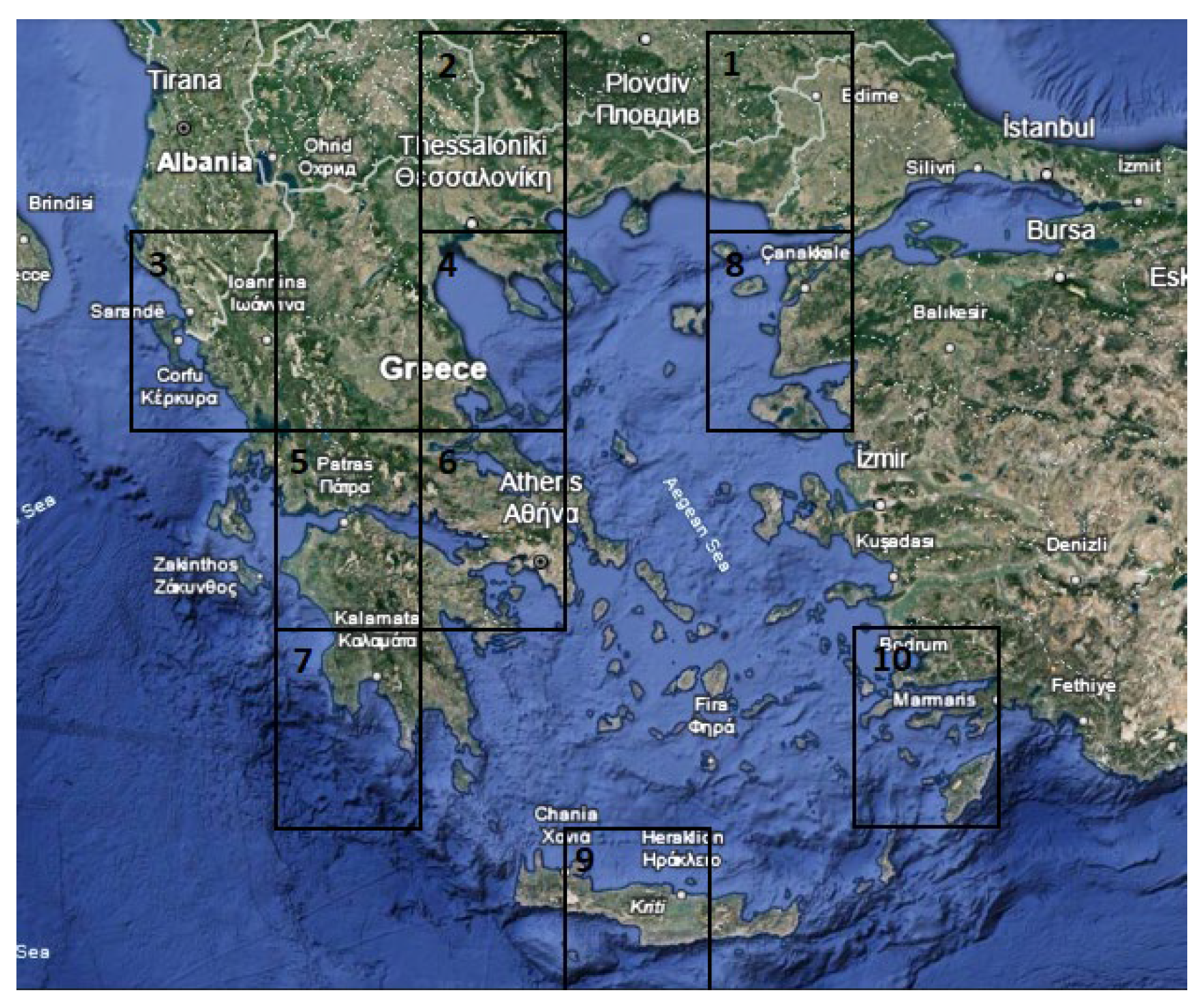

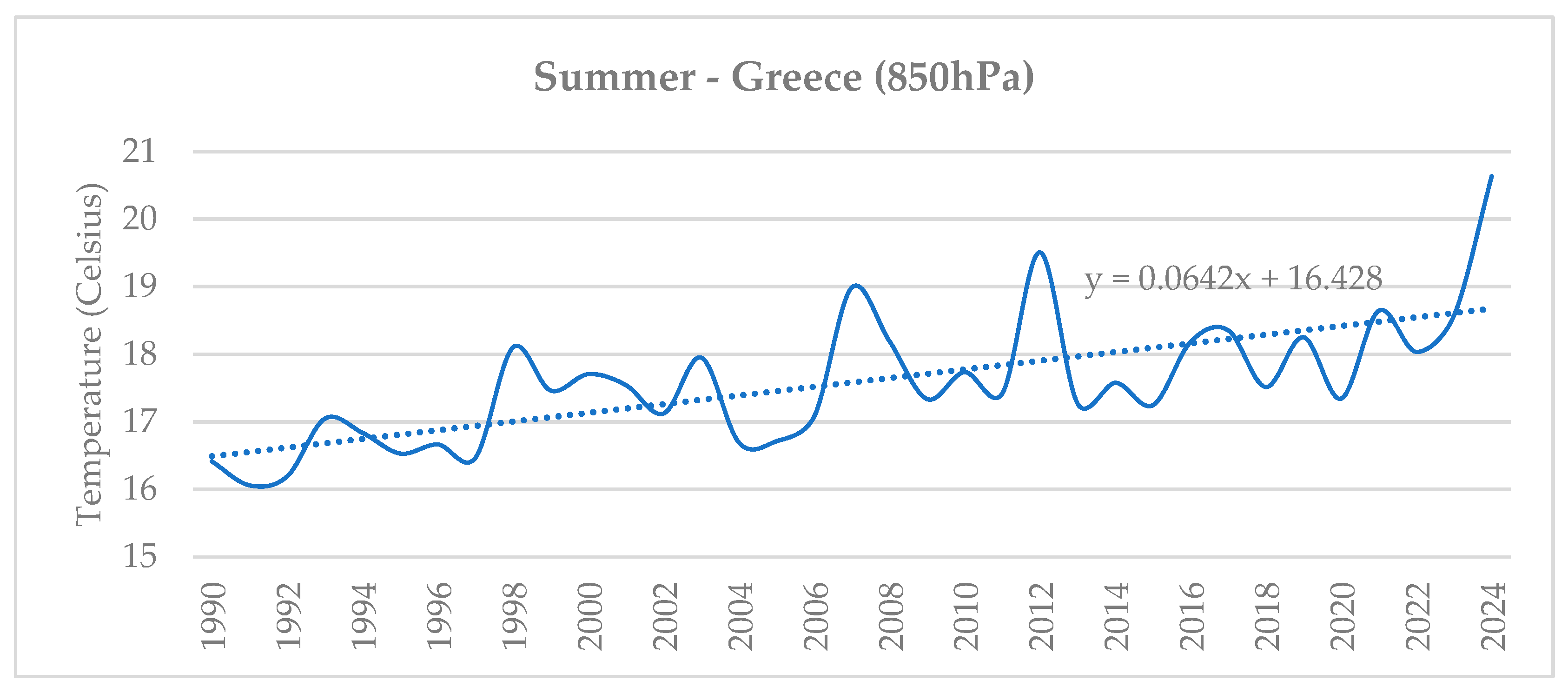

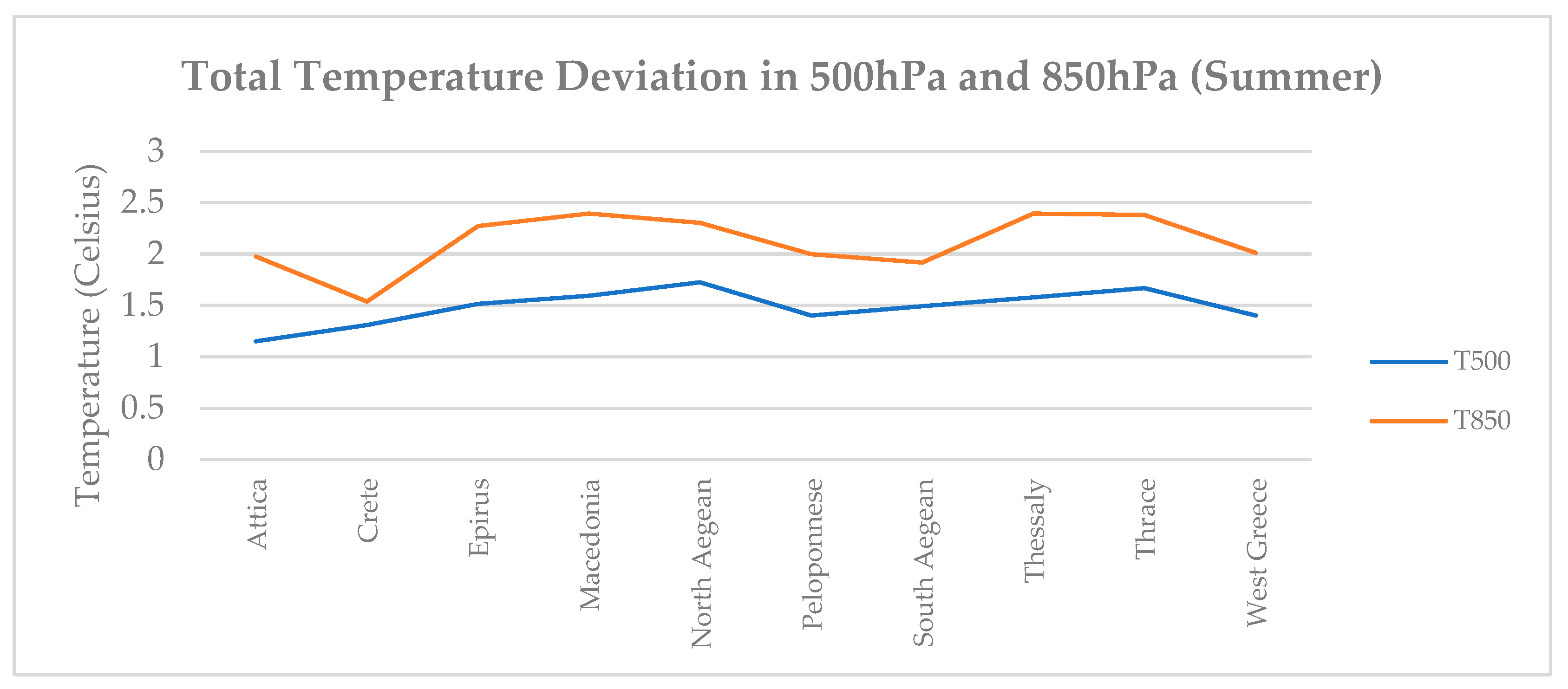
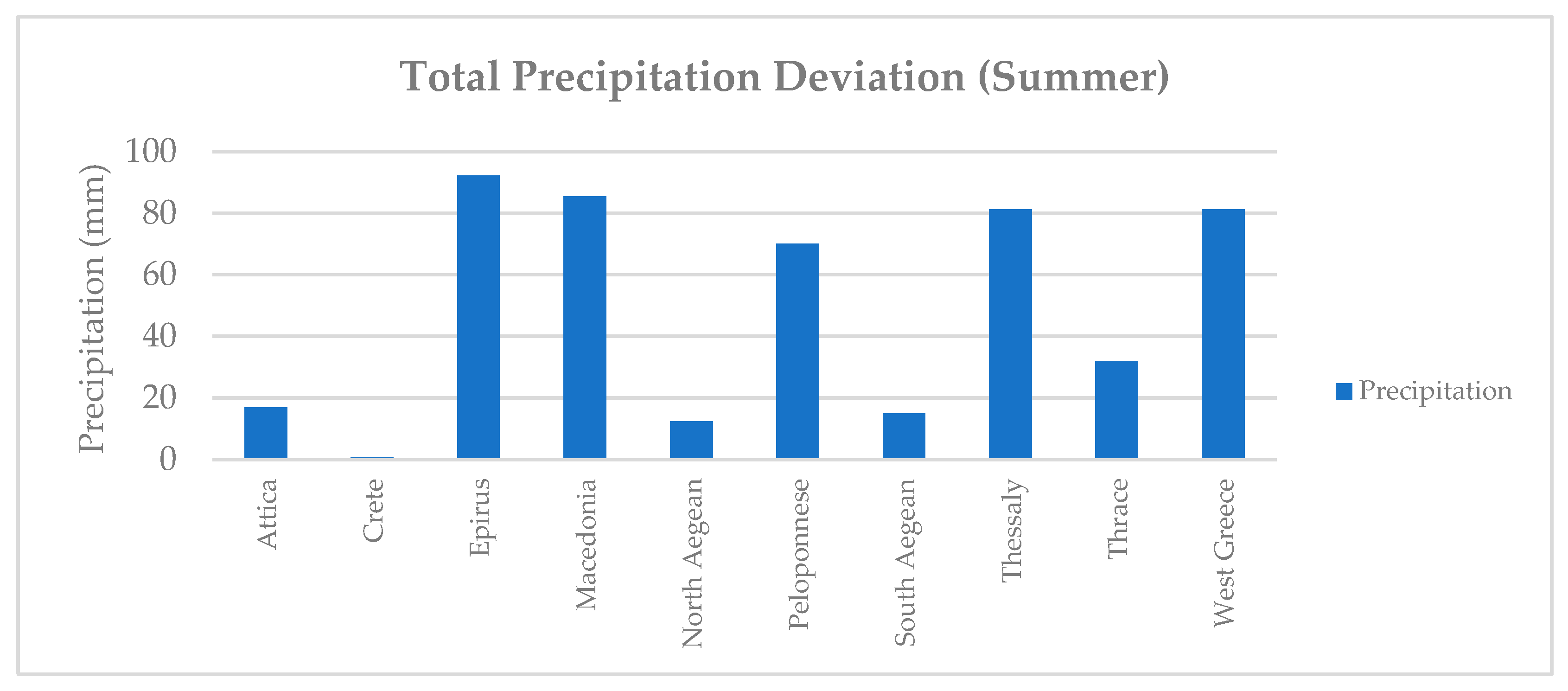
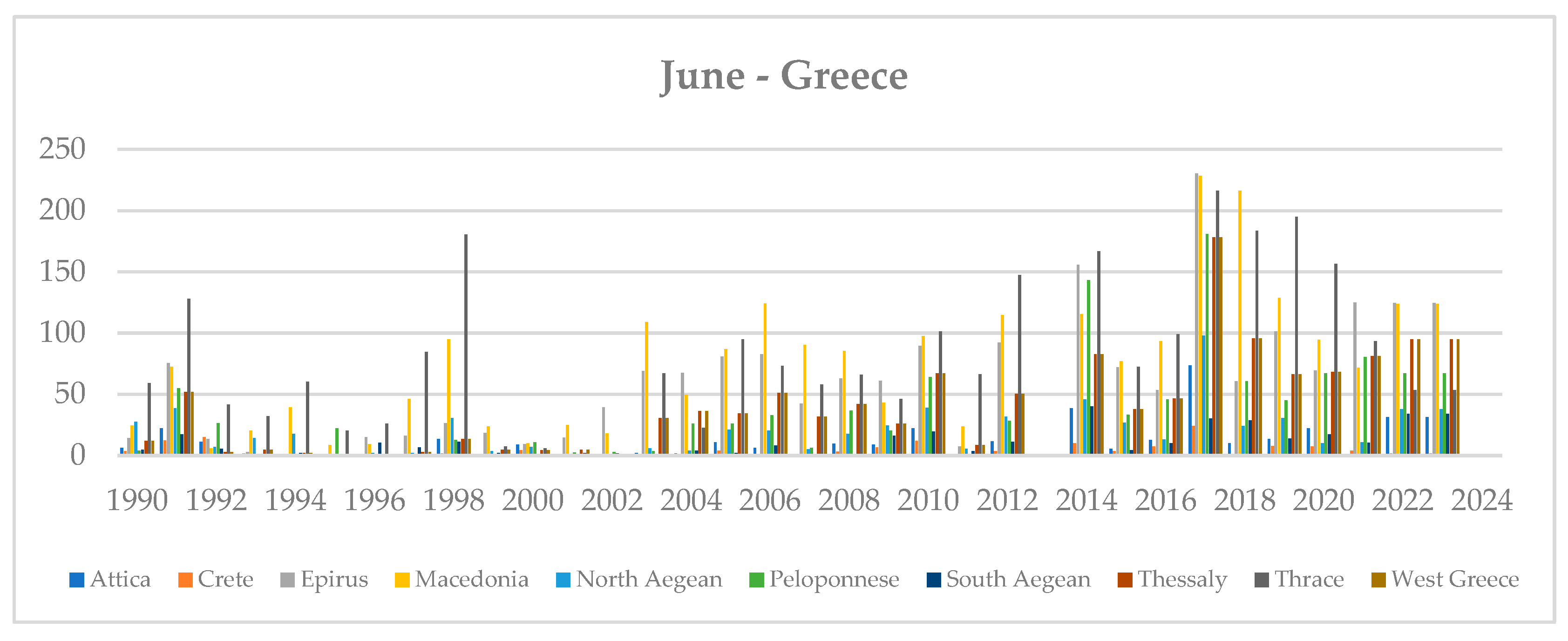
| Region | T500 | T850 | Precipitation |
|---|---|---|---|
| Attica | 0.0349 | 0.0599 | 0.5647 |
| Crete | 0.0396 | 0.0466 | 0.0241 |
| Epirus | 0.0459 | 0.0689 | 3.0740 |
| Macedonia | 0.0483 | 0.0726 | 2.8506 |
| North Aegean | 0.0523 | 0.0698 | 0.4118 |
| Peloponnese | 0.0425 | 0.0605 | 2.3343 |
| South Aegean | 0.0452 | 0.0581 | 0.4976 |
| Thessaly | 0.0478 | 0.0726 | 2.7079 |
| Thrace | 0.0505 | 0.0722 | 1.0617 |
| West Greece | 0.0425 | 0.0610 | 2.7079 |
Disclaimer/Publisher’s Note: The statements, opinions and data contained in all publications are solely those of the individual author(s) and contributor(s) and not of MDPI and/or the editor(s). MDPI and/or the editor(s) disclaim responsibility for any injury to people or property resulting from any ideas, methods, instructions or products referred to in the content. |
© 2025 by the authors. Licensee MDPI, Basel, Switzerland. This article is an open access article distributed under the terms and conditions of the Creative Commons Attribution (CC BY) license (https://creativecommons.org/licenses/by/4.0/).
Share and Cite
Kampolis, D.; Nastos, P. Summers in Greece—Climate Analysis. Environ. Earth Sci. Proc. 2025, 35, 70. https://doi.org/10.3390/eesp2025035070
Kampolis D, Nastos P. Summers in Greece—Climate Analysis. Environmental and Earth Sciences Proceedings. 2025; 35(1):70. https://doi.org/10.3390/eesp2025035070
Chicago/Turabian StyleKampolis, Dimitrios, and Panagiotis Nastos. 2025. "Summers in Greece—Climate Analysis" Environmental and Earth Sciences Proceedings 35, no. 1: 70. https://doi.org/10.3390/eesp2025035070
APA StyleKampolis, D., & Nastos, P. (2025). Summers in Greece—Climate Analysis. Environmental and Earth Sciences Proceedings, 35(1), 70. https://doi.org/10.3390/eesp2025035070







